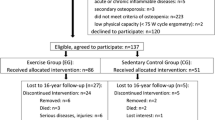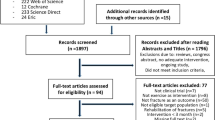Abstract
Summary
In this population-based retrospective cohort study, exercising before and after the diagnosis of type 2 diabetes was significantly associated with lower risk of fractures. This result suggested that exercising might be effective in reducing fracture risk.
Purpose
Patients with diabetes have a significantly higher risk of fractures. We aimed to investigate the association between exercise and fracture risk in new-onset type 2 diabetes.
Methods
This retrospective cohort study using the Korean National Health Insurance Service database included 170,148 patients with new-onset type 2 diabetes who underwent two cycles of health checkup between 2009–2012 and 2011–2014. The patients were classified into four groups (non-exercising, newly exercising, previously exercising, and continuously exercising) and followed up until the date of fracture, death, or December 31, 2018. Hip fractures, vertebral fractures, and any fractures were defined using diagnostic codes.
Results
The proportions of non-exercising, newly exercising, previously exercising, and continuously exercising patients were 65.1%, 15.7%, 10.9%, and 8.3%, respectively. Continuously exercising patients showed the lowest risk for fractures, followed by newly exercising patients using the non-exercising group as a reference. The adjusted hazard ratios (95% confidence intervals) for hip fracture, vertebral fracture, and any fracture were 0.69 (0.50–0.94), 0.73 (0.63–0.84), and 0.90 (0.83–0.97), respectively, in the continuously exercising group and 0.76 (0.61–0.95), 0.85 (0.76–0.94), and 0.93 (0.88–0.98) in the newly exercising group. The risk was lower in patients who lost less than 5% of their body weight than in those who lost 5% or more.
Conclusion
Exercising was associated with lower risk of fractures in newly diagnosed diabetes. However, exercise accompanied by excessive weight loss may not have a significant association with a lower risk of fractures.


Similar content being viewed by others
Data availability
The data presented in this study was available to researchers upon reasonable academic request and with the permission of the Korean NHIS Institutional Data Access (https://nhiss.nhis.or.kr).
References
Hygum K, Starup-Linde J, Langdahl BL (2019) Diabetes and bone. Osteoporos Sarcopenia 5:29-37
Bonds DE, Larson JC, Schwartz AV, Strotmeyer ES, Robbins J, Rodriguez BL, Johnson KC, Margolis KL (2006) Risk of fracture in women with type 2 diabetes: the Women’s Health Initiative Observational Study. J Clin Endocrinol Metab 91:3404–3410
Murray CE, Coleman CM (2019) Impact of diabetes mellitus on bone health. Int J Mol Sci 20:4873
Majumdar SR, Leslie WD, Lix LM, Morin SN, Johansson H, Oden A, McCloskey EV, Kanis JA (2016) Longer Duration of Diabetes Strongly Impacts Fracture Risk Assessment: The Manitoba BMD Cohort. J Clin Endocrinol Metab 101:4489–4496
Lee RH, Sloane R, Pieper C, Lyles KW, Adler RA, Van Houtven C, LaFleur J, Colon-Emeric C (2018) Clinical Fractures Among Older Men With Diabetes Are Mediated by Diabetic Complications. J Clin Endocrinol Metab 103:281–287
Vestergaard P, Rejnmark L, Mosekilde L (2009) Diabetes and its complications and their relationship with risk of fractures in type 1 and 2 diabetes. Calcif Tissue Int 84:45–55
Hong S, Han K (2019) Corrigendum to “The incidence of hip fracture and mortality rate after hip fracture in Korea: A nationwide population-based cohort study” [Osteoporos Sarcopenia 5 (2019) 38–43]. Osteoporos Sarcopenia 5:102
Gulcelik NE, Bayraktar M, Caglar O, Alpaslan M, Karakaya J (2011) Mortality after hip fracture in diabetic patients. Exp Clin Endocrinol Diabetes 119:414–418
Howe TE, Shea B, Dawson LJ, Downie F, Murray A, Ross C, Harbour RT, Caldwell LM, Creed G (2011) Exercise for preventing and treating osteoporosis in postmenopausal women. Cochrane Database Syst Rev (7):CD000333
Wolff I, van Croonenborg JJ, Kemper HC, Kostense PJ, Twisk JW (1999) The effect of exercise training programs on bone mass: a meta-analysis of published controlled trials in pre- and postmenopausal women. Osteoporos Int 9:1–12
Kelley GA, Kelley KS, Tran ZV (2002) Exercise and lumbar spine bone mineral density in postmenopausal women: a meta-analysis of individual patient data. J Gerontol A Biol Sci Med Sci 57:M599-604
de Kam D, Smulders E, Weerdesteyn V, Smits-Engelsman BC (2009) Exercise interventions to reduce fall-related fractures and their risk factors in individuals with low bone density: a systematic review of randomized controlled trials. Osteoporos Int 20:2111–2125
Kemmler W, Haberle L, von Stengel S (2013) Effects of exercise on fracture reduction in older adults: a systematic review and meta-analysis. Osteoporos Int 24:1937–1950
Kemmler W, Bebenek M, Kohl M, von Stengel S (2015) Exercise and fractures in postmenopausal women. Final results of the controlled Erlangen Fitness and Osteoporosis Prevention Study (EFOPS). Osteoporos Int 26:2491–2499
Viggers R, Al-Mashhadi Z, Fuglsang-Nielsen R, Gregersen S, Starup-Linde J (2020) The Impact of Exercise on Bone Health in Type 2 Diabetes Mellitus-a Systematic Review. Curr Osteoporos Rep 18:357–370
Daly RM, Dunstan DW, Owen N, Jolley D, Shaw JE, Zimmet PZ (2005) Does high-intensity resistance training maintain bone mass during moderate weight loss in older overweight adults with type 2 diabetes? Osteoporos Int 16:1703–1712
Fu W, Fan J (2021) Intervention effect of exercise rehabilitation therapy on patients with type 2 diabetic osteoporosis. Am J Transl Res 13:3400–3408
Johnson KC, Bray GA, Cheskin LJ et al (2017) The Effect of Intentional Weight Loss on Fracture Risk in Persons With Diabetes: Results From the Look AHEAD Randomized Clinical Trial. J Bone Miner Res 32:2278–2287
(2021) National Health Insurance Data Sharing Service. Korean National Health Insurance Service. https://nhiss.nhis.or.kr/bd/ab/bdaba000eng.do Accessed Nov 21 2021
Lee SE, Yoo J, Kim KA, Han K, Choi HS (2022) Hip Fracture Risk According to Diabetic Kidney Disease Phenotype in a Korean Population. Endocrinol Metab (Seoul) 37:148–158
Maeda K, Kobayashi Y, Koide M, Uehara S, Okamoto M, Ishihara A, Kayama T, Saito M, Marumo K (2019) The regulation of bone metabolism and disorders by Wnt signaling. Int J Mol Sci 20:5525
Ghardashi-Afousi A, Davoodi M, Hesamabadi BK, Asvadi-Fard M, Bigi MAB, Izadi MR, Gaeini AA (2020) Improved carotid intima-media thickness-induced high-intensity interval training associated with decreased serum levels of Dkk-1 and sclerostin in type 2 diabetes. J Diabetes Complications 34:107469
Jensen LB, Kollerup G, Quaade F, Sorensen OH (2001) Bone minerals changes in obese women during a moderate weight loss with and without calcium supplementation. J Bone Miner Res 16:141–147
Wasnich RD, Miller PD (2000) Antifracture efficacy of antiresorptive agents are related to changes in bone density. J Clin Endocrinol Metab 85:231–236
Balducci S, Conti F, Sacchetti M et al (2019) Study to Weigh the Effect of Exercise Training on BONE quality and strength (SWEET BONE) in type 2 diabetes: study protocol for a randomised clinical trial. BMJ Open 9:e027429
Stehouwer CDA (2018) Microvascular Dysfunction and Hyperglycemia: A Vicious Cycle With Widespread Consequences. Diabetes 67:1729–1741
Shieh A, Greendale GA, Cauley JA, Karvonen-Gutierriez C, Harlow SD, Finkelstein JS, Liao D, Huang MH, Karlamangla AS (2022) Prediabetes and insulin resistance are associated with lower trabecular bone score (TBS): cross-sectional results from the Study of Women’s Health Across the Nation TBS Study. Osteoporos Int 33:1365–1372
Sakai M, Ohtera S, Iwao T, Neff Y, Kato G, Takahashi Y, Nakayama T, BiDame, (2019) Validation of claims data to identify death among aged persons utilizing enrollment data from health insurance unions. Environ Health Prev Med 24:63
Acknowledgements
National Health Information Database was provided by the National Health Insurance Service (NHIS). The authors would like to thank the NHIS for their cooperation. We would like to thank Harisco for English language editing.
Author information
Authors and Affiliations
Corresponding author
Ethics declarations
Ethics approval
All procedures performed in studies involving human participants were in accordance with the ethical standards of the institutional and/or national research committee and with the 1964 Helsinki declaration and its later amendments or comparable ethical standards. Because we used previously collected, publicly available, de-identified data, this study was exempted from ethical review by the Institutional Review Board.
Informed consent
Informed consent was waived because data analyses were performed retrospectively using anonymized data derived from the South Korean NHIS database.
Conflict of interest
None.
Additional information
Publisher's note
Springer Nature remains neutral with regard to jurisdictional claims in published maps and institutional affiliations.
Supplementary Information
Below is the link to the electronic supplementary material.
Rights and permissions
Springer Nature or its licensor (e.g. a society or other partner) holds exclusive rights to this article under a publishing agreement with the author(s) or other rightsholder(s); author self-archiving of the accepted manuscript version of this article is solely governed by the terms of such publishing agreement and applicable law.
About this article
Cite this article
Lee, S.E., Yoo, J., Kim, BS. et al. Association between exercise and risk of fractures in new-onset type 2 diabetes: a retrospective cohort study. Arch Osteoporos 18, 61 (2023). https://doi.org/10.1007/s11657-023-01240-y
Received:
Accepted:
Published:
DOI: https://doi.org/10.1007/s11657-023-01240-y




